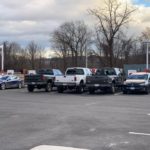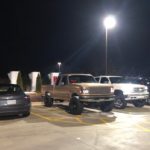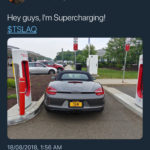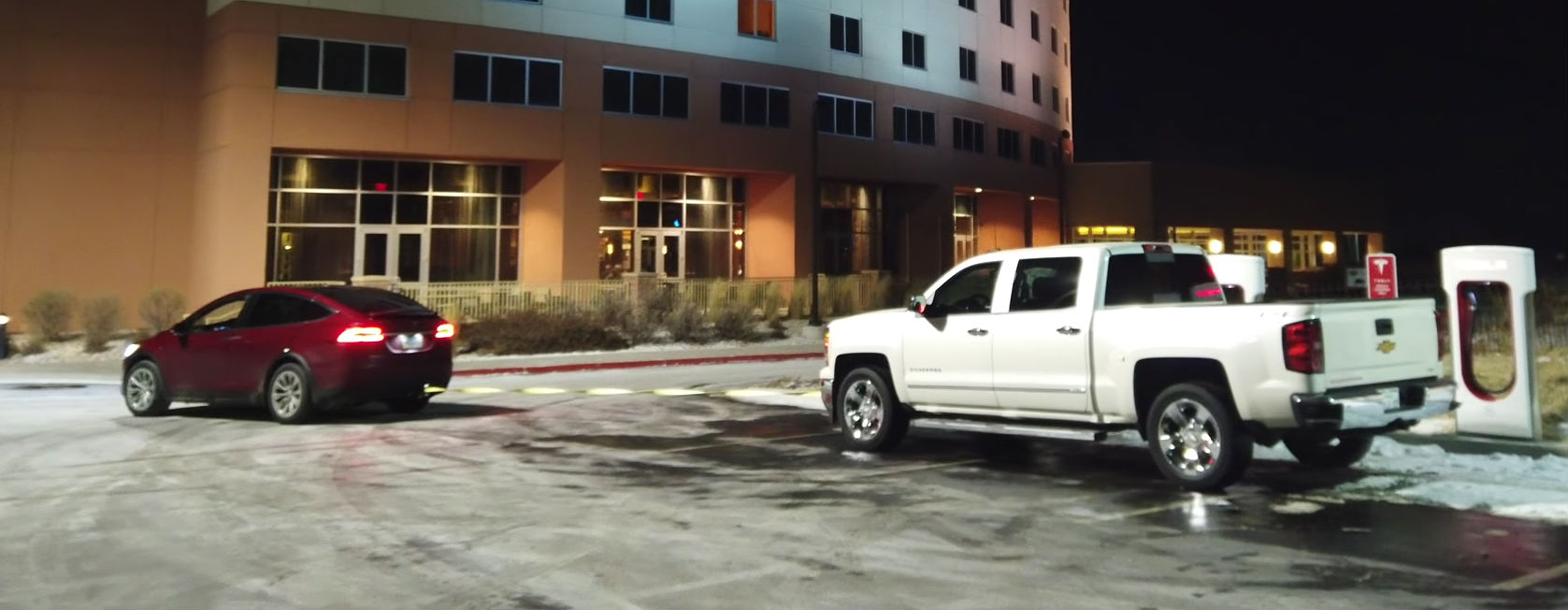

News
Tesla Model X easily tows Chevy Silverado 1500 from Supercharger in ‘De-ICE-ing’ feat
There is no denying that Tesla’s electric cars are bound to be polarizing for a long time to come. Operating independent of gasoline, the vehicles are practically a stand against the fossil fuel industry. Being sleek, powerful and quick, the cars also go against the notion that electric cars are boring and slow. Unfortunately, as Teslas become more commonplace with the ramp of the Model 3, the vehicles appear to be attracting more resistance from the anti-EV community as well.
Last month, several members of the Tesla community went online to share their experiences with a practice colloquially known as “ICE-ing,” which involves gasoline and diesel powered vehicles blocking access to a Supercharger. While some of these incidents might be the result of an honest mistake, some ICE-ing incidents are undoubtedly intentional. Noted TSLA short Mark Spiegel, for example, has proudly shown off his Porsche Boxster S blocking a Supercharger stall earlier this year. Tesla owners u/Leicina and u/BarcodeOfficial from the r/TeslaMotors subreddit uploaded photos of stations being intentionally blocked by pickup truck drivers as well. As noted by the Tesla owners, some of the truck drivers were even verbally harassing EV owners.
- Pickup trucks ICE-ing a Tesla Supercharger. (Photo: BarcodeOfficial/Reddit)
- Pickup trucks ICE-ing a Tesla Supercharger. (Photo: Leicina/Reddit)
- Tesla short-seller Mark Spiegel blocking a Supercharger station. (Photo: Mark Spiegel/Twitter)
Amidst these annoying (and disturbing to a point) incidents, one thing that these pickup truck drivers could easily forget is that Tesla’s electric cars are actually loaded with a lot of power, and they have the weight to back it up. Being equipped with electric motors, Tesla’s vehicles have a lot of torque, and thanks to their massive battery packs, they are also very heavy. The Tesla Model X, for example, was at its lightest at 5,072 pounds, and that was when the company was still selling the 60D variant. Thus, in theory, a Tesla should be able to tow an offending vehicle out of a Supercharger station if needed, or as a last resort in the event of an emergency.
Such a theory was recently put to the test by Tesla Model X 90D owner Patrick Lawson. In a video posted on his Tesla Trip YouTube channel, Patrick opted to see if his all-electric SUV would be able to tow a full-sized pickup truck out of a Supercharger. Fortunately for the Model X owner, his sister recently acquired a 2014 Chevrolet 1500 Silverado, and she was more than willing to see if her 5,104-lb pickup could be towed by the electric vehicle. Patrick opted to conduct the experiment at an empty Supercharger in Loveland, CO, and to make the scenario even more challenging; he opted to engage the truck’s emergency brake, simulating a situation where a driver intentionally leaves a vehicle parked for an extended period of time.
In the video, Patrick could be seen hooking up his Model X to the Chevy Silverado 1500, then slowly driving away, pickup truck in tow. From what could be seen in the experiment, the entire ‘De-ICE-ing” process was effortless for the all-electric SUV, with Patrick noting in a conversation with Teslarati that he had to “show constraint” as he “gently pressed on the Model X’s accelerator” to ensure that both vehicles don’t get damaged. The Model X did not have to engage Slip Start before it towed the Silverado as well, and no warnings were present on the vehicle while it was pulling the full-sized pickup. Ultimately, Patrick noted that entire “De-ICE-ing” process only took around five minutes.
With the ramp of the Model 3, Tesla’s electric cars are becoming more prevalent. Unfortunately, acts like ICE-ing Superchargers would likely continue as well. And it’s not just ICE-ing either. Some Tesla owners, among them racecar driver Leilani Münter, have noted on Twitter that she had been “coal-rolled” multiple times while driving in her Tesla. In a tweet, Elon Musk described these situations as “bizarre.”
Inasmuch as ICE-ing, or coal-rolling for that matter, is an annoyance that could escalate into something more dangerous, there is very little that the anti-EV crowd can do to stop the spread of electric cars. Countries across the globe such as China, which are large markets for the auto industry, are shifting to electric vehicles, and so are regions like Europe. Thanks to cars like the Model 3, electric vehicles are becoming more and more attainable as well. Coupled with a grid that is shifting towards cleaner energy, it would only be a matter of time before the auto industry shifts completely to electric.
Watch Patrick Lawson’s video of his Tesla Model X “de-ICE-ing” a Supercharger below.
News
Tesla UK sales see 14% year-over-year rebound in June: SMMT data
The SMMT stated that Tesla sales grew 14% year-over-year to 7,719 units in June 2025.

Tesla’s sales in the United Kingdom rose in June, climbing 14% year-over-year to 7,719 units, as per data from the Society of Motor Manufacturers and Traders (SMMT). The spike in the company’s sales coincided with the first deliveries of the updated Model Y last month.
Model Y deliveries support Tesla’s UK recovery
Tesla’s June performance marked one of its strongest months in the UK so far this year, with new Model Y deliveries contributing significantly to the company’s momentum.
While the SMMT listed Tesla with 7,719 deliveries in June, independent data from New AutoMotive suggested that the electric vehicle maker registered 7,891 units during the month instead. However, year-to-date figures for Tesla remain 2% down compared to 2024, as per a report from Reuters.
While Tesla made a strong showing in June, rivals are also growing. Chinese automaker BYD saw UK sales rise nearly fourfold to 2,498 units, while Ford posted the highest EV growth among major automakers, with a more than fourfold increase in the first half of 2025.
Overall, the UK’s battery electric vehicle (BEV) demand surged 39% to to 47,354 units last month, helping push total new car sales in the UK to 191,316 units, up 6.7% from the same period in 2024.
EV adoption accelerates, but concerns linger
June marked the best month for UK car sales since 2019, though the SMMT cautioned that growth in the electric vehicle sector remains heavily dependent on discounting and support programs. Still, one in four new vehicle buyers in June chose a battery electric vehicle.
SMMT Chief Executive Mike Hawes noted that despite strong BEV demand, sales levels are still below regulatory targets. “Further growth in sales, and the sector will rely on increased and improved charging facilities to boost mainstream electric vehicle adoption,” Hawes stated.
Also taking effect this week was a new US-UK trade deal, which lowers tariffs on UK car exports to the United States from 27.5% to 10%. The agreement could benefit UK-based EV producers aiming to expand across the country.
News
Tesla Model 3 ranks as the safest new car in Europe for 2025, per Euro NCAP tests
Despite being on the market longer than many of its rivals, the Tesla Model 3 continues to set the bar for vehicle safety.

The Tesla Model 3 has been named the safest new car on sale in 2025, according to the latest results from the Euro NCAP. Among 20 newly tested vehicles, the Model 3 emerged at the top of the list, scoring an impressive 359 out of 400 possible points across all major safety categories.
Tesla Model 3’s safety systems
Despite being on the market longer than many of its rivals, the Tesla Model 3 continues to set the bar for vehicle safety. Under Euro NCAP’s stricter 2025 testing protocols, the electric sedan earned 90% for adult occupant protection, 93% for child occupant protection, 89% for pedestrian protection, and 87% for its Safety Assist systems.
The updated Model 3 received particular praise for its advanced driver assistance features, including Tesla’s autonomous emergency braking (AEB) system, which performed well across various test scenarios. Its Intelligent Speed Assistance and child presence detection system were cited as noteworthy features as well, as per a WhatCar report.
Other notable safety features include the Model 3’s pedestrian-friendly pop-up hood and robust crash protection for both front and side collisions. Euro NCAP also highlighted the Model 3’s ability to detect vulnerable road users during complex maneuvers, such as turning across oncoming traffic.
Euro NCAP’s Autopilot caution
While the Model 3’s safety scores were impressive across the board, Euro NCAP did raise concerns about driver expectations of Tesla’s Autopilot system. The organization warned that some owners may overestimate the system’s capabilities, potentially leading to misuse or inattention behind the wheel. Even so, the Model 3 remained the highest-scoring vehicle tested under Euro NCAP’s updated criteria this year.
The Euro NCAP’s concerns are also quite interesting because Tesla’s Full Self-Driving (FSD) Supervised, which is arguably the company’s most robust safety suite, is not allowed for public rollout in Europe yet. FSD Supervised would allow the Model 3 to navigate inner city streets with only minimal human supervision.
Other top scorers included the Volkswagen ID.7, Polestar 3, and Geely EX5, but none matched the Model 3’s total score or consistency across categories. A total of 14 out of 20 newly tested cars earned five stars, while several models, including the Kia EV3, MG ZS, and Renault 5, fell short of the top rating.
Elon Musk
Why Tesla’s Q3 could be one of its biggest quarters in history
Tesla could stand to benefit from the removal of the $7,500 EV tax credit at the end of Q3.

Tesla has gotten off to a slow start in 2025, as the first half of the year has not been one to remember from a delivery perspective.
However, Q3 could end up being one of the best the company has had in history, with the United States potentially being a major contributor to what might reverse a slow start to the year.
Earlier today, the United States’ House of Representatives officially passed President Trump’s “Big Beautiful Bill,” after it made its way through the Senate earlier this week. The bill will head to President Trump, as he looks to sign it before his July 4 deadline.
The Bill will effectively bring closure to the $7,500 EV tax credit, which will end on September 30, 2025. This means, over the next three months in the United States, those who are looking to buy an EV will have their last chance to take advantage of the credit. EVs will then be, for most people, $7,500 more expensive, in essence.
The tax credit is available to any single filer who makes under $150,000 per year, $225,000 a year to a head of household, and $300,000 to couples filing jointly.
Ending the tax credit was expected with the Trump administration, as his policies have leaned significantly toward reliance on fossil fuels, ending what he calls an “EV mandate.” He has used this phrase several times in disagreements with Tesla CEO Elon Musk.
Nevertheless, those who have been on the fence about buying a Tesla, or any EV, for that matter, will have some decisions to make in the next three months. While all companies will stand to benefit from this time crunch, Tesla could be the true winner because of its sheer volume.
If things are done correctly, meaning if Tesla can also offer incentives like 0% APR, special pricing on leasing or financing, or other advantages (like free Red, White, and Blue for a short period of time in celebration of Independence Day), it could see some real volume in sales this quarter.
You can now buy a Tesla in Red, White, and Blue for free until July 14 https://t.co/iAwhaRFOH0
— TESLARATI (@Teslarati) July 3, 2025
Tesla is just a shade under 721,000 deliveries for the year, so it’s on pace for roughly 1.4 million for 2025. This would be a decrease from the 1.8 million cars it delivered in each of the last two years. Traditionally, the second half of the year has produced Tesla’s strongest quarters. Its top three quarters in terms of deliveries are Q4 2024 with 495,570 vehicles, Q4 2023 with 484,507 vehicles, and Q3 2024 with 462,890 vehicles.
-

 Elon Musk5 days ago
Elon Musk5 days agoTesla investors will be shocked by Jim Cramer’s latest assessment
-

 News1 week ago
News1 week agoTesla Robotaxi’s biggest challenge seems to be this one thing
-

 Elon Musk2 weeks ago
Elon Musk2 weeks agoFirst Look at Tesla’s Robotaxi App: features, design, and more
-

 News2 weeks ago
News2 weeks agoWatch Tesla’s first driverless public Robotaxi rides in Texas
-

 News2 weeks ago
News2 weeks agoWatch the first true Tesla Robotaxi intervention by safety monitor
-

 Elon Musk2 weeks ago
Elon Musk2 weeks agoTesla to launch in India in July with vehicles already arriving: report
-
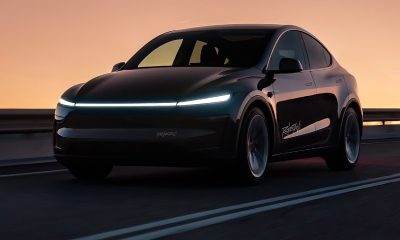
 Elon Musk2 weeks ago
Elon Musk2 weeks agoTesla officially launches Robotaxi service with no driver
-

 Elon Musk1 week ago
Elon Musk1 week agoA Tesla just delivered itself to a customer autonomously, Elon Musk confirms

